Italy
Italy
The following Nativities are each displayed in a unique permanent setting created by Marian Library Crèche Collection volunteers. The descriptive text for each was written by Father Johann Roten, S.M.
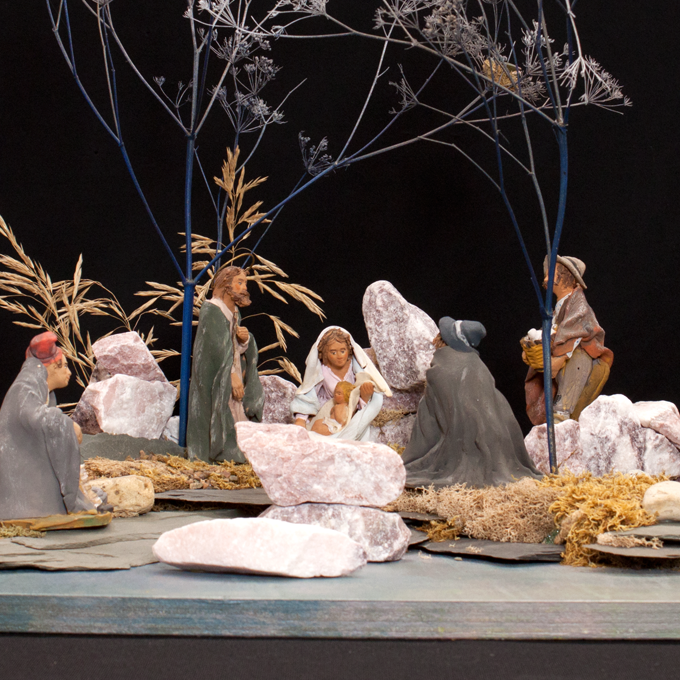
Lightness of Being
Genella Ossi
There are nativity sets which desperately beg for surroundings to define them: a house, a landscape or a story. Others speak for themselves, and stand out wherever you place them. They stand tall and define their milieu. This is one of those sets. It was discovered by chance in Rome's Piazza Navona where it stood, dusty and forgotten, on the shelves of one of the many Christmas stands. What attracted the visitor was its lightness of being. Pale and aged, the colors don't have a life of their own but blend in discreetly with the overall stance of the figures. The movement, used economically, is mainly in the flow of the robes and mantles. It directs the attention to faces and gestures. And here is where lightness of being finds its true expression: in the twinkling of an eye, a hat worn cockily or tired with age, a moustache twitching with laughter. The deeper meaning is shown in the lightness with which simple but generously measured gifts of eggs, poultry and vegetables are brought before the child. And with a similar gesture of lightness of being, the Madonna presents her own gift to the three magi cum shepherds: her very son and God's gift to the world. She looks like a refugee from one of the many Raphael paintings, underscoring even more the lightness of being of the whole tableau.
– ML.0116.11
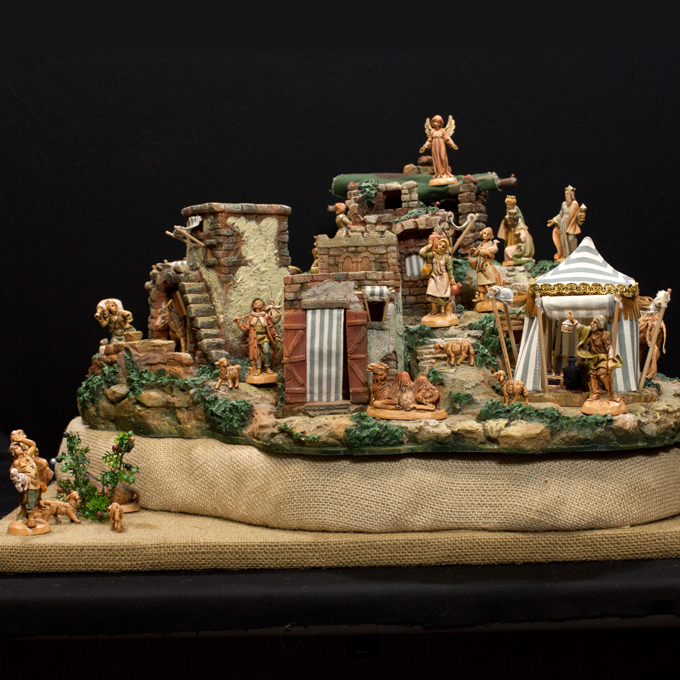
All Roads Lead to the Manger
Fontanini Family
Flat roof tops, tightly clustered houses and narrow streets suggest a near Eastern location. The nativity stable sits on top of the hillside, dominating the village. Although steep and narrow, all roads lead to the manger. Not only beggars, but also kings have to climb the hill of Christ's presence. However long the way, however many the obstacles, the goal, the manger, remains visible from all directions, and the angel is there to encourage the tardy and the lazy and the confused. This set is part of the vast Fontanini assortment of figures and accessories, a long-standing Italian Christmas tradition with frequently added elements.
– ML.0157
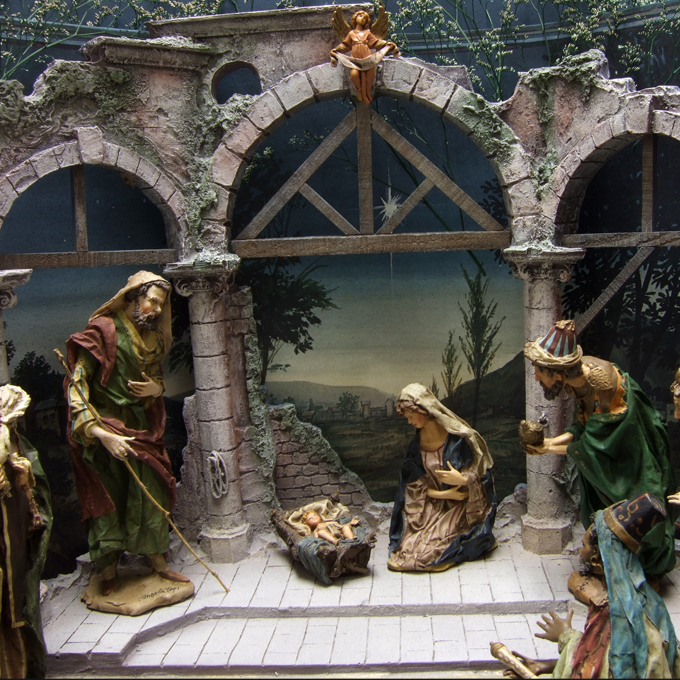
Life Is Theater
Angela Tripi, Peter Wolf
This set wants to convey drama. Its setting is the stage, its scenery the customary ruins of Italian creches, and the actors strike poses of reverence and submissiveness. They are clothed in flowing robes, indicating wealth and refinement for the magi, and decently covered shabbiness for the others, the Holy Family and the lone shepherd. In the wings are standing more actors waiting their turn to enter the scene. The backdrop reaches far into a landscape painted in colors of chiaro-scuro, suggesting a battle between darkness and light. The main pointer for this Christmas message are the ruins. The monuments and temples of pre-Christian cultures are slowly disintegrating and collapsing. Out of their ruins are growing new life and a new culture. Growth and development will not be easy. Light and darkness will clash frequently, but the Child in the manger will be a constant measuring rod for goodness and evil.
– ML.0126.09, 14
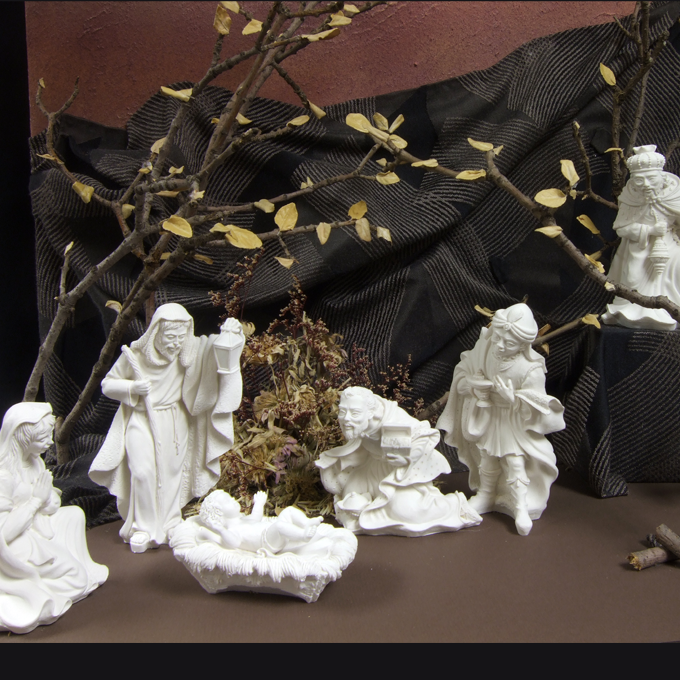
Ringing in Eternal Spring
Artist unknown
These white gleaming figures are crafted in great detail. Note the finely-detailed design of the robes, the delicate fingers and textured hair. This unknown Italian ceramist's set is displayed in a drab winter setting of brown and tawny tans. The colors of winter and barrenness give way to the tender green leaves of blossoming trees. Trees standing in bloom or bearing fruit are frequently used in crèche sets to announce the mysterious and wonderful birth of Jesus Christ.
– ML.0115.16
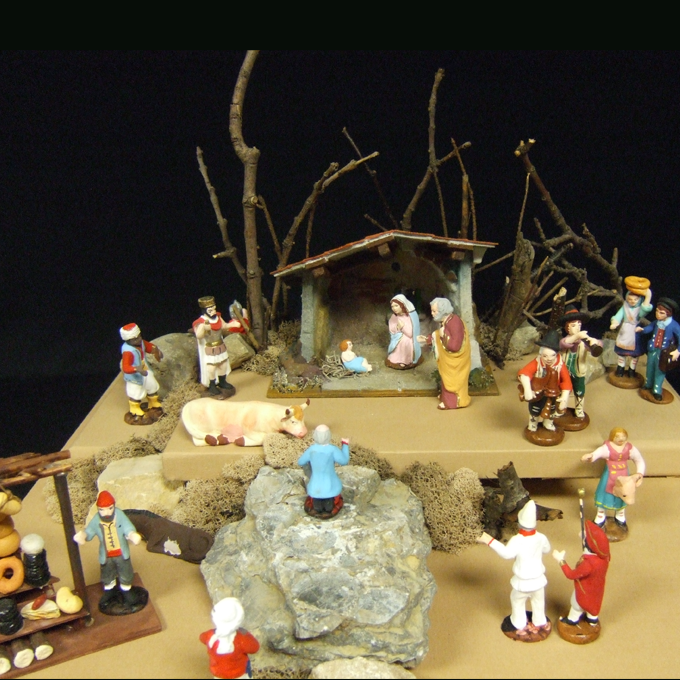
A Common Yearning
Unknown artist
This popular Roman nativity has a number of unusual figures, among them the poor soul burning in Purgatory, a soldier murdering the innocent and Pierrot, the clown. However, far or estranged from the child-redeemer, they all share in a common longing for liberation from the dark sides of human condition.
This chalet-type construction – not uncommon in the Italian regions of the Alps – is a mere pretext of a house. The chalet gives shelter only to mother and son, but it centers the whole Christmas scene. This is frequently the case in sets with an important number of figures. They need to be distributed in a way which allows the on-looker to see and admire them. And since all of these crèche characters are pilgrims en route to the Christ child, the house with the baby becomes the center of attention. This Roman nativity has a number of unusual figures, among them the poor soul burning in purgatory, a soldier murdering the innocent, and Pierrot, the clown. Somehow they are all longing for shelter from damnation, wrath and punishment.
– ML.0122.24, 26
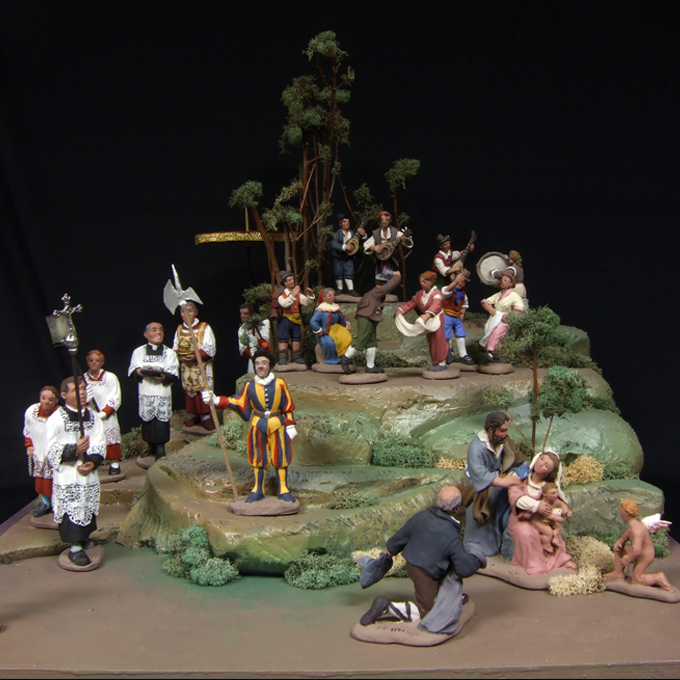
Then and Now
Alberto Finizio
Rome
This nativity set offers two different but complementary views of Christianity. We have to the right the traditional Christmas scene enlivened by music and dance. On the left side we see a procession reminiscent of Corpus Christi. Both of these scenes have an unmistakable Roman flavor. Costumes and musical instruments are those of the Romagna, the region around Rome. The three-step invitation to dancing follows patterns of old-world courtesy and flourish. The holy couple, engaged in lively exchange, projects a definite local color. The gallantry of the kneeling farmer and the darling little angel are of a similar verve.
The nativity set is a reflection about the past, the birth of Christ. The procession with baldachino, altar boys, Swiss guards and a bishop carrying the holy species reflects the present, and is the fruit of the Incarnation. Without Christmas there is no Corpus Christi.
– ML.1140.01
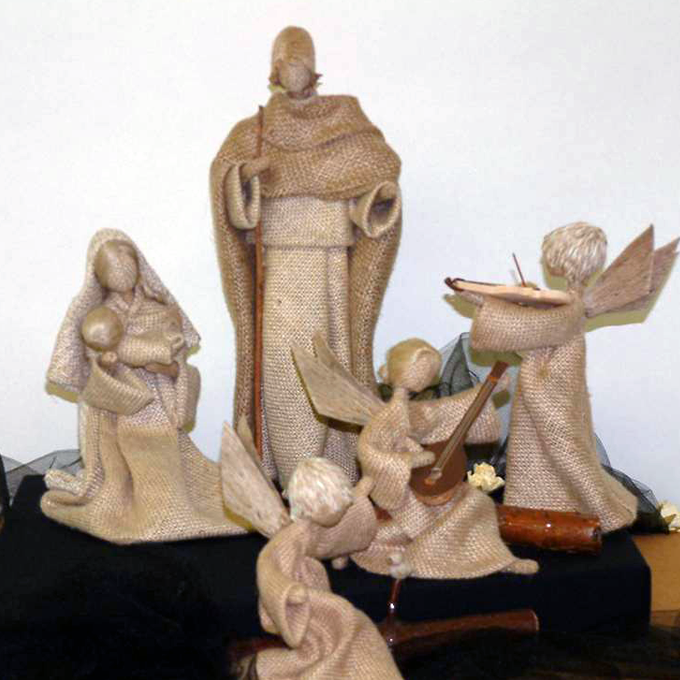
A Symphony of Burlap
Maria degli Angeli
The artist is a Carmelite sister from the northern region of Italy (Aosta). Her work is a symphony of burlap. Using burlap to craft her figures, she has a wonderful ability to make the personages of the crèche come alive with noble beauty. Frequently recalcitrant and taxing for any artist’s touch, burlap becomes like putty in the sister’s hand, but still achieves to convey the sober and simple dignity of the Incarnation.
– ML.1118.07
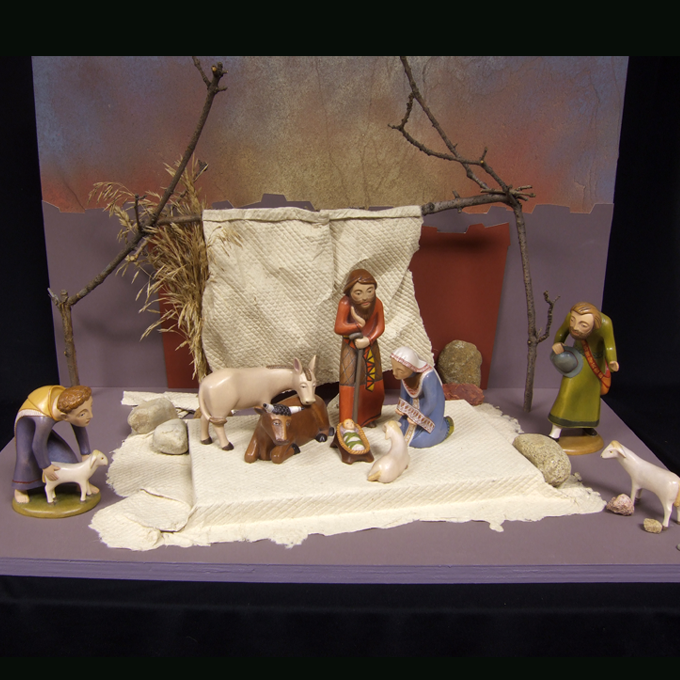
Stooped Backs
Fabio Perella
Each one of these figures is a little masterpiece in its own right. On the other hand, they all have a similar posture and express a common attitude or disposition. Their heads and necks are bent, and their backs are rounded. Superficial perception suggests that these personages have become stooped with age. But take another look at the unlined faces and bodies full of vigor. Their expression and posture is graceful, full of tender awe and loving admiration. Standing or kneeling, these figures are mesmerized and entranced before the miracle of God become man. The finely carved silhouettes and delicately colored surfaces emphasize the spiritual quality which pervades the whole scene. This must be the face of true faith. It invigorates the soul and transforms the body. Faith gives human existence a new lightness and spiritual sensitivity.
– ML.0139.02
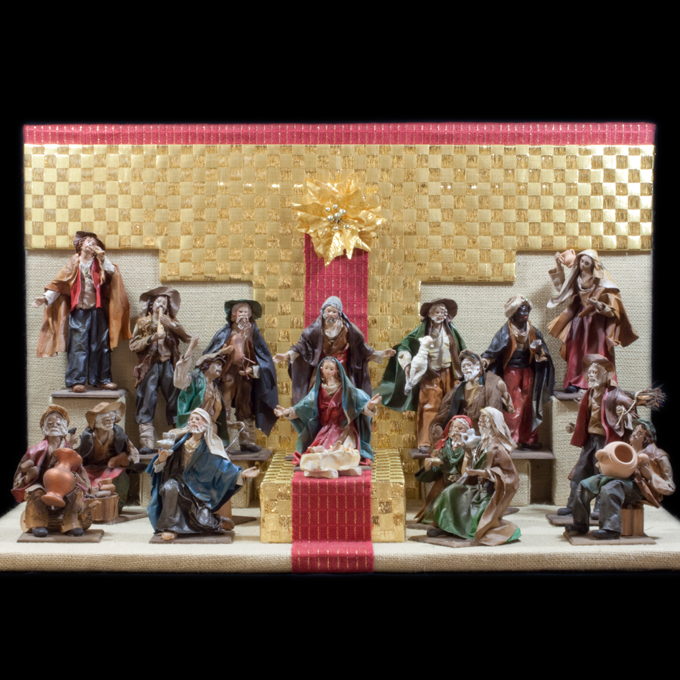
If Hands Could Talk
Lecce Tradition
And yes! They talk in this nativity set. This should not come as a surprise. Drama is an integral part of Italian nativities. Not only in the famous Neapolitan crèches, but also among the poor cousins of Lecce in the Apulia. A well established Nativity tradition in its own right, the figures made in Lecce are of paper maché and terra cotta but they have the same ample gesture, wide mantles, and strong faces as the Neapolitan aristocrats. Wide and welcoming are the gestures of Mary and Joseph, those of other figures point to the manger. Thus a dialogue ensues for the benefit of the onlooker. Come numerous, come all, is the message of the Holy Couple. Right there, right there at the manger, come all! Answer musicians, shepherds, and kings. A few recalcitrants resist; they are lost in their pots and pans.
[Elisabeth van Mullekom Collection]
– MLA.336
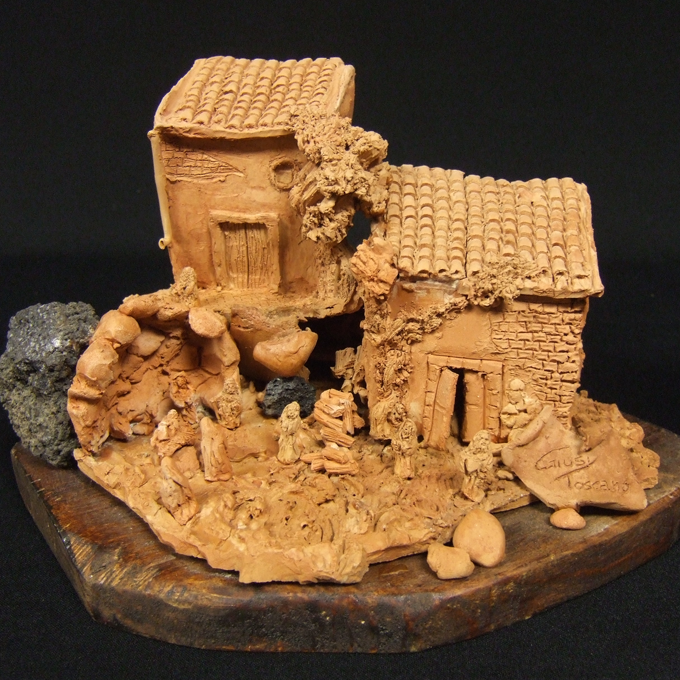
A Lava Nativity (1 of 2)
Giusy Toscano
Toscano lives in Rome but is Sicilian of origin. The village of her family lies at the foot of Mount Aetna. Lava, the typical rock of the region is part of Giusy’s geographical heritage. The house of her parents is built on ancient rocks of lava. Thus, lava reminds Giusy of home.
On her visits to her native Sicily she would take pieces of lava back to Rome and incorporate them into her artwork. The little village in this set is a tribute to home and family. It juxtaposes a representation of Mother and Child, they, too, placed on top of a small rock of lava. Together, Our Lady and the Christ Child represent a different kind of home: the joy and security in the one who calls himself the Prince of Peace.
– ML.1952.1
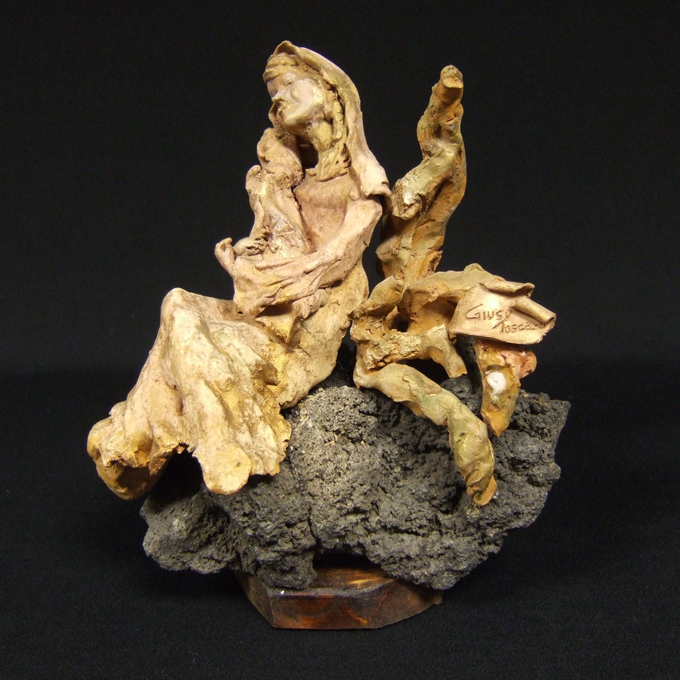
A Lava Nativity (2 of 2)
Giusy Toscano
Toscano lives in Rome but is Sicilian of origin. The village of her family lies at the foot of Mount Aetna. Lava, the typical rock of the region is part of Giusy’s geographical heritage. The house of her parents is built on ancient rocks of lava. Thus, lava reminds Giusy of home.
On her visits to her native Sicily she would take pieces of lava back to Rome and incorporate them into her artwork. The little village in this set is a tribute to home and family. It juxtaposes a representation of Mother and Child, they, too, placed on top of a small rock of lava. Together, Our Lady and the Christ Child represent a different kind of home: the joy and security in the one who calls himself the Prince of Peace.
– ML.1952.2
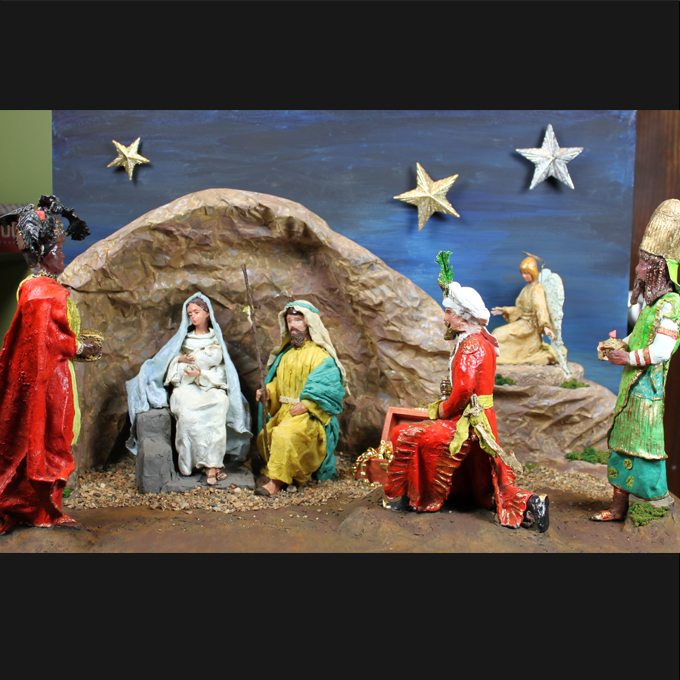
The Grotto
Unknown artist
Lecce Tradition
Painted paper maché
"On the third day after the birth of our Lord Jesus Christ holy Mary went out from the cave, and went into a stable and put her child in a manger" (Pseudo-Matthew 14). The grotto in this set seeks to prevent impressions of hiddenness (cave) and enclosure (stable). The event of the nativity is a message for all. It is wide open to a sometimes despairingly checkered clientele. Indeed, what do the three magnificent kings have in common with the typical magi of the crèche? The magi with the oversized golden tarbush-like headdress and straight and square beard has all the trappings of an Assyrian king. In front of him and kneeling we have an Indian Maharaja coiffed in a while turban with peacock feathers. The third king is ornately dressed in red and yellow robes, his crown bobbing with a bouquet of ostrich feathers, a symbol of African royalty. There is no known boundary to imagination. The Holy Family unperturbed extends a welcome to the unexpected, to what seems singular, anomalous, curious, and even queer.
– ML.2396
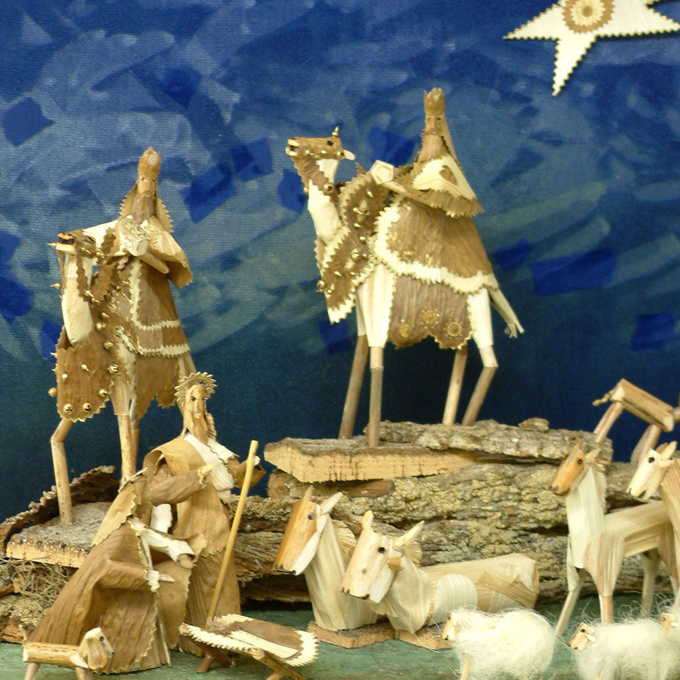
Matter Matters
G. Serra
There are not only crèches made of resin and polymer. Although the more common materials have been wood and clay, we also have Nativity sets made from wax and straw, peat and bone, or, as in this scene, from the leaves, twigs and little branches of the giant fennel (ferulae). Ferula is a genus of stately herbaceous perennials, native to the Mediterranean, western and central Asia. Sardinia being an island of the Mediterranean Sea, the giant fennel is one of the typical and common materials used by the natives. It was the genius of the artist which made the giant fennel come alive as gentle piglet, stately horse, and majestic camel.
– ML.2647
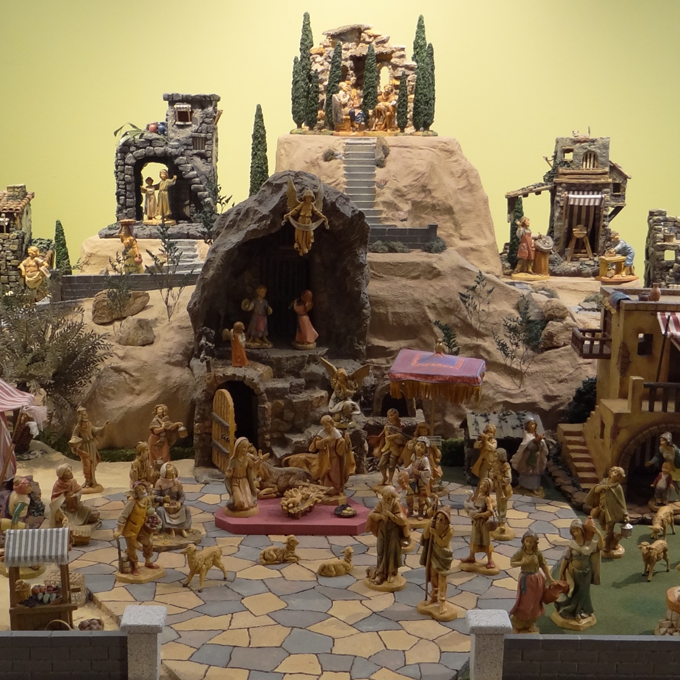
Fontanini Village
The figures on the hilltop of this Fontanini landscape repesent Saint Francis of Assis and Emanuele Fontanini. History and legend attribute to Saint Francis a major role in popularizing the Nativity tradition. Many people see in the Holy Night of Greccio in 1223 the origin of the crèche, the manger story. In fact, what Francis saw and understood was the true graneur of the humble little God in the manger. Emanuele Fontanini is the founder of the Fontanini Heirloom Nativities. These figures have been created in Bagni di Lucca since 1908, and reflect some of the rich artistic heritage of the Tuscan Renaissance. Colorful, dramatic, or contemplative, most of the over 60 Fontanini characaters owe their existence to the inspiration and skill of master sculptor Elio Simonetti. In their conversation acrss centuries, Saint Francis and Emanuele Fontanini may reflect on the love for the crèche tradition and its lasting value for humanity. If Saint Francis insists on the religious and spiritual truth of the nativity, Fontanini chimes in with his concern to make the truth beautiful.
The figures, house, and accessories displayed are the gift of Sherley Snapp.
